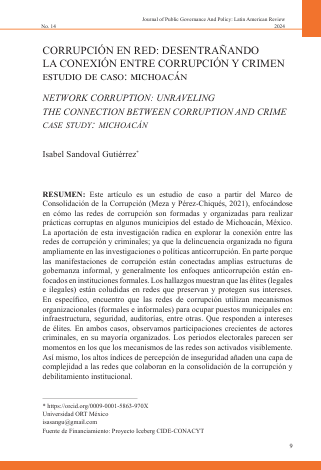Corrupción en red: desentrañando la conexión entre corrupción y crimen.
Estudio de caso: Michoacán
Keywords:
Corruption Consolidation Framework, networks, corruption, crimeAbstract
This article is a case study based on the Corruption ConsolidationFramework (Meza & Pérez-Chiqués 2021), focusing on how corruption networksare formed and organized to carry out corrupt practices in some municipalitiesin the state of Michoacán, Mexico. The contribution of this research lies inexploring the connection between corruption and criminal networks; sinceorganized crime does not figure widely in anti-corruption investigations orpolicies. Partly because manifestations of corruption are connected to broadinformal governance structures, and anti-corruption approaches are generallyfocused on formal institutions. The findings show that elites (legal and illegal)collude in networks that preserve and protect their interests. Specifically, I find that corruption networks use organizational mechanisms (formal and infor-mal) to occupy municipal positions in: Infrastructure, security, audits, among others. That respond to elite interests. In both cases, we observe increasingparticipation of criminal actors, mostly organized. Electoral periods seem tobe moments in which network mechanisms are visibly activated. Likewise, thehigh rates of perception of insecurity add a layer of complexity to the networksthat collaborate in the consolidation of corruption and institutional weakening.




